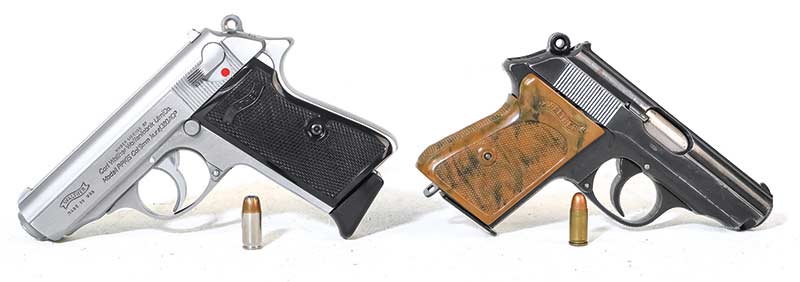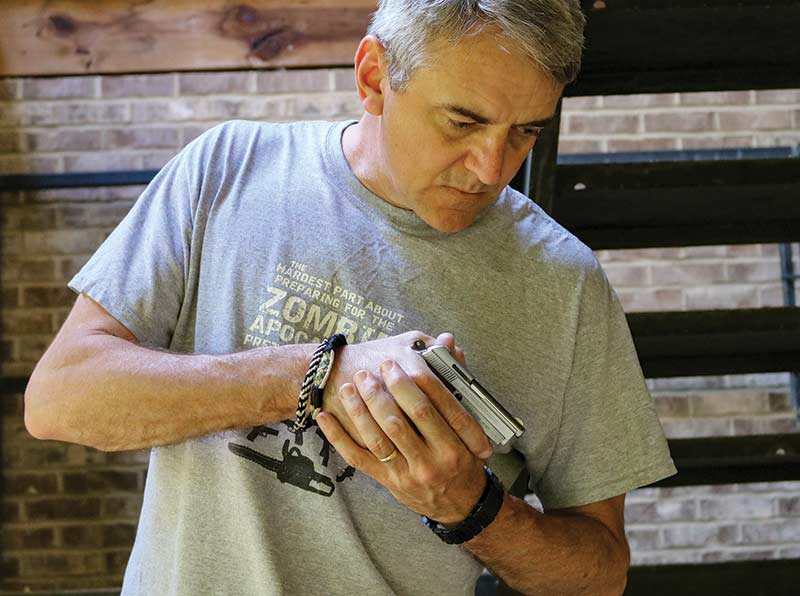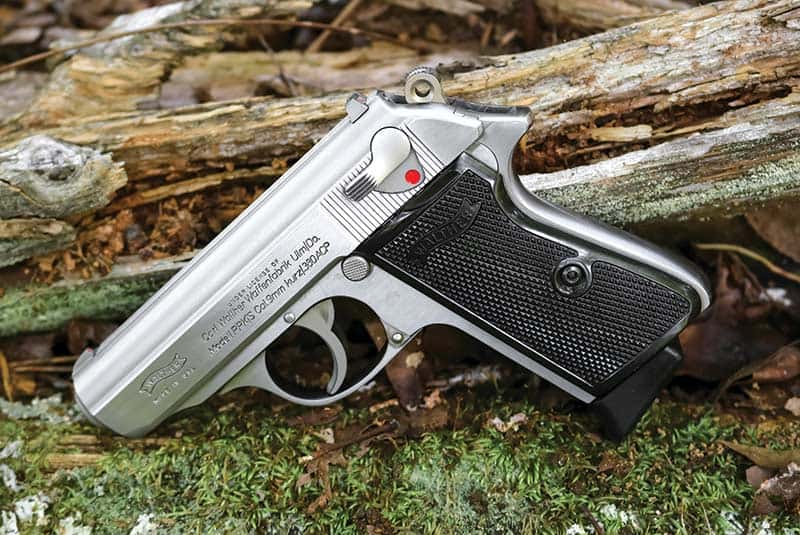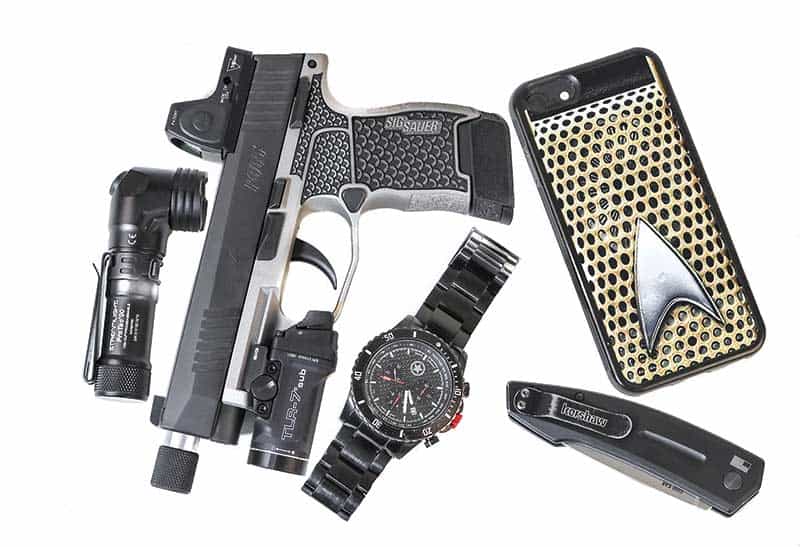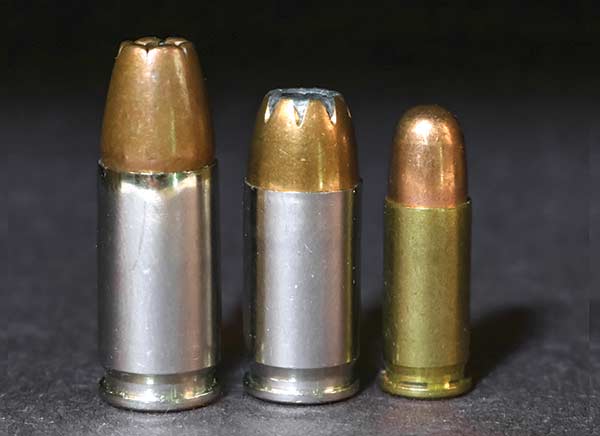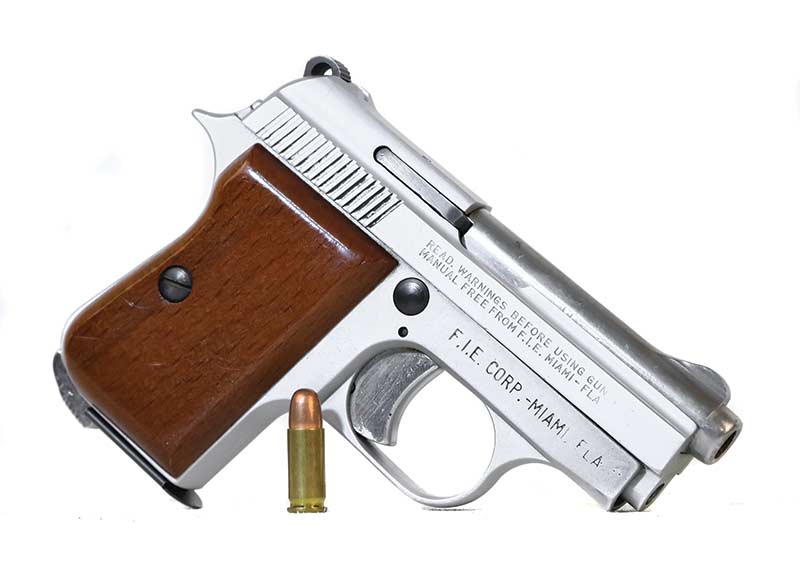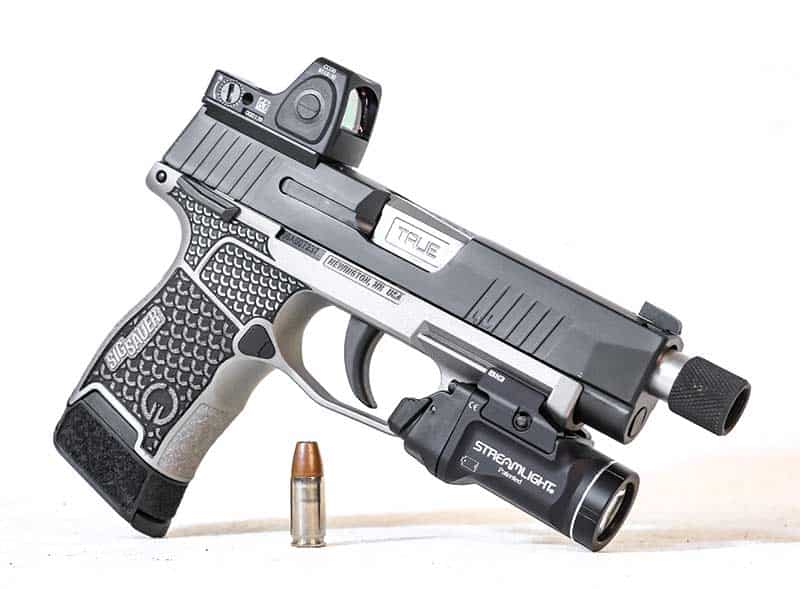S&W Model 65 in .357 Magnum

From the CCRKBA . . .
Democrats in the Washington State Legislature put politics ahead of constitutional rights Saturday when they voted 27-21 to approve House Bill 1240, which bans the future sale, manufacture and importation of so-called “assault weapons,” the Citizens Committee for the Right to Keep and Bear Arms said today.
“Contrary to Democrats in Olympia, who sound like they’re reading from the same script, modern semiautomatic firearms are not ‘weapons of war’,” said CCRKBA Chairman Alan Gottlieb. “This ban will not improve public safety, as proponents such as Attorney General Bob Ferguson have asserted. It will only impair the rights of law-abiding citizens, while doing absolutely nothing to prevent criminals from committing murder and mayhem, and they know it.”
The legislation, which goes back to the House for concurrence, does not ban possession of semiautomatic rifles, shotguns or handguns by people who already own them.
“One or more lawsuits challenging this legislation will almost certainly be filed within days, if not hours, of Gov. Jay Inslee’s signing,” Gottlieb predicted. “Ultimately, we expect this law to be nullified by the courts as a violation of the Second Amendment and Washington State’s constitution. In the meantime, of course, Evergreen State gun owners will continue to be treated like second-class citizens by the self-righteous zealots behind the ban, while the criminal element will remain undeterred and unencumbered.
“Proponents of this legislation have touted the results of a poll done last year by the Northwest Progressive Institute showing that 56 percent of Washington voters support a ban,” he continued. “What they overlook is that constitutional rights are not subject to popularity polls, a fact we expect the courts to remind them about in the days ahead.
“The truly sad part about this is that people who have been gulled into believing a gun ban will have any major impact on violent crime are going to find out the hard way they were misled by the gun prohibition lobby,” Gottlieb observed. “All this accomplishes is that it gives anti-gunners an excuse to celebrate at the expense of law-abiding Washington citizens who have committed no crime, and whose only sin is that they choose to exercise a constitutionally protected right. Where’s the justice, or even the logic, in that?”

The fight for Bakhmut in east Ukraine continues as Russian forces close in and Ukrainian soldiers repel them. In one fortified gun position, Bakhmut’s defenders are using a machine gun first invented almost 140 years ago. The Maxim gun, a belt fed machine gun, has become one of the reliable iconic weapons of the war.
“It only works when there is a massive attack going on…then it really works,” Borys, a soldier fighting for Ukraine, told the BBC. “So we use it every week”.

Ukraine has become a battlefield where advanced weaponry such as the IRIS-T air defense system and hypersonic missiles are being used for the first time. It’s a place where drones dominate the airspace and social media pages fill up with footage of every success and failure. But it’s also shown that older tactics and proven weapons can still be useful in a conflict as brutal and protracted as the war in Ukraine.
First invented in 1884, the Maxim Machine gun was the first fully automatic machine gun. The gatling gun predates it, but required someone to turn a crank to fire. The version of the Maxim that’s become popular in Ukraine is the M1910 model.
Maxims have been used in the Russo-Ukraine war nearly since the conflict began. Russia first invaded Ukraine with proxy forces in 2014 and the earliest footage of the weapon comes from a Ukrainian news network in 2016.

The M1910 Maxim was mass produced in Tsarist Russia. Its use has now outlived both the Tsar and Soviet communism. The antique weapon design is still popular because it’s easy to use, easily modified, and fires a standard 7.62x54mm cartridge that’s been used in Russia since 1891. It’s belt fed and water-cooled. A well-serviced Maxim can, theoretically, fire indefinitely without overheating so long as it’s fed both ammo and water.
That kind of reliability makes it a boon when a soldier is holding an entrenched position and fending off a heavy assault from infantry. That’s the position some of the Ukrainian defenders of Bakhmut currently find themselves in.
Soldiers in Ukraine are also heavily modifying the Maxim gun, making the 1910 model look and fire like a more modern weapon. The arms researcher Calibre Obscura surfaced a video of Ukrainian soldiers using a Maxim gun outfitted with modern optics, basic camouflage, a stock, and a suppressor. This is a weapon that typically sets in an entrenched position mounted on a heavy piece of steel. This modified version is a quieter, but not silent, burst fire weapon.
In another pair of videos pulled from TikTok, soldiers in Ukraine have attached four Maxim guns to a remote controlled rig that can spin 360 degrees. A video of a test fire showed a soldier aiming all four Maxim guns at once, each belt fed from ammunition canisters strapped to the rig.
I had signed into Fort Rucker, Ala., a few days prior to my actual report date. It left a long weekend to kill before settling into the grind at our new Army post. As the beach was a mere hour and a half south, we decided to go sample the sugar white sand of Panama City.
On the drive back north, we stopped at the shopping mall in Dothan to stretch our legs and grab a bite. My son was a toddler. As a result, either my wife or I had to be physically managing him all the time lest he wander into traffic. This meant we went to the restroom in shifts.
When it was my turn, there was one other guy in the john. I don’t make a habit of studying guys in the restroom, so I just knew he was an older gentleman. As he left the institutional mall bathroom, a group of a dozen or so boisterous young men piled in.
They were loud and obnoxious as young men in herds typically tend to be. They were cursing and slamming into things. They went from one end of the restroom to the other, kicking in the stall doors to ensure no one was lurking therein. Then they got to me.
I was still facing the urinal doing my business when one of the young men came up behind me and popped me with a quick rabbit punch between the shoulder blades. I leaned forward but caught myself reflexively before becoming one with the urinal. I then put myself together and turned around to face the assembled crowd.
At the time, I was young, fit and hard — a trained soldier. However, they outnumbered me a dozen to one. They now stood silent in a semicircle, facing me, their arms collectively crossed. We exchanged stares, and they said not a word.
It was then I realized I might be about to die in a restroom in the Dothan, Ala. shopping mall. I might have taken a couple of them on a good day, but these were rangy 17-year-olds wearing gang colors. There was no way I was going to best them all collectively.
I slipped my hand into my right front pocket, slipped the latch on the butterfly knife that was my constant companion and said a little prayer. Without a word, I walked toward the largest of the lot, turning sideways to squeeze between him and his nearest companion. Throughout the episode, they all remained inexplicably fixated on the urinal. I’m fairly certain it was the prayer that got me out of that restroom alive.
Once outside, I found my precious wife innocently beaming. The elderly gentleman who had been in the restroom originally was apparently considerably more street-savvy than was I. He had posted himself outside the restroom and was telling others to find another venue. He said there was a gang meeting going on inside.
I gathered my family and left. However, I found I did not much care for the feeling of helplessness I had experienced during this sordid little episode. I drove directly from the shopping mall to the nearby county seat to apply for my very first concealed carry permit.
Administrative Details
Back in the early ’90s in Alabama, the application for a concealed carry permit was but a single page. The permit was good for a year and cost $15. You filled it out at the local sheriff’s office.
I documented the demographic data and got to the part about supplying three references. As these were the days before cell phones and I had not come prepared with my address book, I struggled to come up with addresses and phone numbers for three people who were not family members. When the sweet lady behind the counter saw I was struggling, she said, “Son, don’t fret about that stuff. We ain’t calling any of those people anyway.”
The plan was to leave the application with the sheriff. They would run a background check overnight while it was slow, and then I could pick up the permit the following day. When I arrived the next morning, the same lady apologized and said they had been too busy to run the checks the night before. As it was a half-hour drive from home, and I would soon be really short on discretionary time, I was clearly disappointed. She said, “Aww, hell, you look like an honest guy,” and signed my form.
I was both surprised and grateful. When she noted my confusion, she asked me if I had ever been frisked by the police. I replied I had not. She went on to explain I could have carried a concealed weapon every day from first grade to the present and no one ever would have known. She said the fact I was standing there meant I needed it and criminals didn’t make a habit of asking the police for permission to carry a gun. Hers was the most profound wisdom I have ever heard from a government servant.
Finally, Firepower
Now that I had the paper, I needed a gun. Mine was a hunting family. I had a bunch of long guns to include an AR-15 and a Chicom Type 56 AK. However, I had not grown up with handguns. The only pistol I owned was an FIE Titan in .25 ACP.
My precious wife bought me the tiny little gun for my birthday the previous year for $50. I liked it because it was a pistol. She liked it because it was cute. This diminutive .25-caliber heater was all the gun we could afford at the time.
The Titan was technically the Tanfoglio GT27. This single-action, blowback-operated semi-automatic pistol fed from a seven-round magazine and weighed three quarters of a pound loaded. The lightweight cast frame was formed from some weird cheap alloy called Zamak. Production began in 1962.
The GT27 fell prey to the import restrictions imposed by the 1968 Gun Control Act. The GCA was intended to restrict availability of cheap “Saturday Night Specials.” I was living proof sometimes cheap “Saturday Night Specials” were all a working man could afford. As a result, the American companies Excam and FIE (Firearms Import and Export) brought the parts in from Italy and assembled them domestically as a workaround.
I carried the little gun loose in my right front pocket where my butterfly knife used to ride. I kept the chamber empty and practiced charging the weapon as part of its retrieval. I couldn’t afford a better pistol, but I stoked it with Glaser Safety Slugs.
Safety Slugs were serious defensive medicine back then. Basically, a formed bullet jacket packed with fine lead shot and topped with a polymer tip, these flimsy little 1/4″ bullets likely would not have penetrated much past a T-shirt. Regardless, I was finally packing heat.
Evolution
I saved up my pennies and bought a stainless steel Walther PPK/S in .380 ACP. I packed it in a small-of-the-back leather holster I borrowed from a friend. I recall the first time I went to the local Walmart with that thing underneath a T-shirt feeling like I was glowing orange. After a while, I came to appreciate folks either couldn’t tell I was packing a gun or didn’t care. It was, after all, the point of the exercise.
The PPK/S with its steel frame and seven-round magazine capacity was fairly heavy. However, the superb single-action/double-action trigger allowed me to carry the gun safely with a round in the chamber. I kept the slide-mounted safety on just in case and trained to flick it off on the draw. Then as now, I am diagnosable-paranoid about negligent discharges. It’s one of the reasons over many decades of shooting and hundreds of thousands of rounds, I’ve yet to have one.
I pack something high capacity, lightweight and plastic these days. I am armed whenever I am not asleep or in the shower. I have had need of a gun twice for real since then and found myself prepared both times. Had I faced that gang with nothing but my trusty FIE Titan they likely would have killed me. However, I would have at least had the means to make them work for it.
Ruminations
Just before Christmas 1984, Bernie Goetz used a J-Frame Smith & Wesson revolver to wound four hustling teenagers on a New York subway train. Though they played themselves as victims at the time, the teens later admitted their intent had been to rob Goetz. When Goetz was tried for the shooting, fully half of his jurors had themselves been victims of New York street crime. He was acquitted of everything but illegal weapons possession.
This watershed event really birthed the concealed carry movement in America. Like me, many to most Americans were fed up with being defenseless in the face of criminals who ignored the law. Nowadays more than 19 million Americans hold a valid concealed carry license, and 20 states allow concealed carry without a permit. In a nation with 196 million adults, it means at least one-tenth of the population packs heat. It’s been an interesting trip getting here.
- Since 2017, US military service branches have been rolling out new M17 and M18 handguns.
- The new guns are only the latest in a history of sidearms that stretches back to the first Continental soldiers.
US soldiers, sailors, airmen, and Marines have quickly received the the military’s newest pistols in massive numbers.
The US Army awarded Sig Sauer the contract for the new Modular Handgun System in January 2017. By 2018, other service branches had placed their own orders for the M17 and M18 variants.
By November 2019, Sig Sauer had delivered well over 100,000 of the new sidearms. Deliveries reached 200,000 in November 2020 — the first month the pistols were sent to all military branches simultaneously.
The M17 and the compact M18 variant are the latest in a long line of sidearms that US troops have carried into battle since 1776.
The flintlocks
The American military’s early sidearms were often privately owned. Officers, able to afford more expensive weapons, usually had dueling pistols, while rank-and-file soldiers made due with whatever they could get from local gunsmiths. This led to an array of armaments with varying calibers and qualities.
The Continental Congress tried to get a standard sidearm to the Continental Army. The pistol it chose was a direct copy of the British Model 1760 flintlock pistol. The Congress bought 2,000 of the pistols, dubbed the Model 1775, which were made by the Rappahannock Forge in Virginia.
The .62-caliber smoothbore single-shot flintlock, which included an iron or ash ramrod under the barrel, is considered the first US Army-issued handgun.
The pistol was well received during the Revolution. After the war, a new version, known as the Model 1805, was made at Harper’s Ferry. This flintlock saw service in the War of 1812 and remained the US Army’s standard-issue pistol for over 50 years.
Two Model 1805s are featured on the US Army Military Police Corps insignia, and a similar pistol can be seen on the US Navy SEAL emblem.
Colt revolvers
In 1836, inventor Samuel Colt revolutionized warfare when his first revolver design was patented.
The new weapon allowed a soldier to fire six bullets in as many seconds without pausing to reload. It also used percussion caps, which allowed soldiers to shoot reliably in wet weather.
Colt revolvers were important weapons in the US arsenal for much of the 19th century, with at least four designs — the Colt 1847, the Colt M1848 Dragoon, the Colt Army Model 1860, and the Colt Single Action Army — seeing service.
The Colt 1847, known as the “Walker” for the Texas Ranger who helped design it, was based on previous Colt designs in service with the Republic of Texas and became the first mass-produced revolver in US service.
The Walker and the Dragoon, another .44-caliber revolver adopted by US Army cavalry and mounted-infantry units, saw service in the Mexican-American War and on both sides of the US Civil War.
The most popular Colt design of the 19th century was the Colt Army Model 1860, a .44-caliber revolver adopted just before the Civil War. It was used in large numbers by the Union and the Confederacy — 130,000 were built for the Union alone, and over 200,000 had been made by the time production ceased in 1873.
The invention of metallic cartridges again revolutionized firearms, eliminating the need for percussion caps, a separate powder container, and ramrods. Colt’s most well-known model featuring this innovation was the Colt Single Action Army.
The new revolver fired a .45-caliber center-fire cartridge and was a huge success, becoming a standard sidearm for the US for more than 20 years. It saw action in every US war and military campaign until 1905 and was used extensively on the US Western frontier by bandits and government personnel alike, earning it nicknames like “the Peacemaker.”
Some soldiers, such as Gen. George S. Patton, carried their personal Colt SAAs with them as late as World War II.
The last revolver in US service was the M1917, a six-shot pistol made by Colt and Smith & Wesson and introduced for interim use. After World War I, M1917s were used mostly by support units, though they again saw frontline service with the Vietnam War’s tunnel rats.
M1911
In 1911, the US military adopted what would become one of the most iconic firearms in history — the M1911.
Designed by firearms legend John Browning, the .45 ACP pistol was a semiautomatic, single-action, recoil-operated pistol capable of firing seven rounds from a magazine held in the grip of the gun.
The M1911 was one of the most popular weapons in American history. It was the standard-issue sidearm, with few changes, for all branches of the US military for more than 70 years and saw action in almost every American conflict during that period, including both World Wars, Korea, Vietnam, and the US invasion of Grenada in 1983.
The M1911 was officially replaced in 1985, but a number of special-operations units carried them into 21st century. It was so popular that the Marine Corps brought it back into limited service in 2012 in the form of the M45A1 CQBP.
M9
In 1986, the military selected the Italian Beretta 92 as the new sidearm for all branches.
Lightweight and modern, the pistol used the smaller 9 x 19 mm round, enabling it to carry 15 rounds in the magazine, double that of the M1911, but at the cost of less penetration power.
In service as the M9, the pistol was used by US troops for 30 years and saw action in Yugoslavia, the Gulf Wars, Afghanistan, and other operations during the War on Terror.
The Pentagon bought more than 600,000 M9s, but they had reliability problems and had gained a bad reputation by the 2010s. In 2015, the US Army and Air Force began searching for a replacement.
M17/M18
In January 2017, Sig Sauer’s P320 was announced as the winner of the XM17 Modular Handgun System competition. The pistol has two variants: the full-length M17 and the compact M18.
The Army received its first M17s in June 2017. The Air Force began its procurement in June 2019, and the Marine Corps started officially fielding the M18 in September.
The pistols can be configured for different missions and have a rail on which accessories like lasers and optical sights can be mounted. Their standard capacity of 17 9-mm rounds can be increased to 21 with an extended magazine.
The Pentagon plans to buy 420,000 M17s and M18s for $580 million over a 10-year period.
